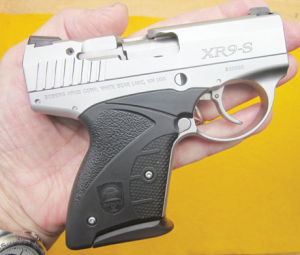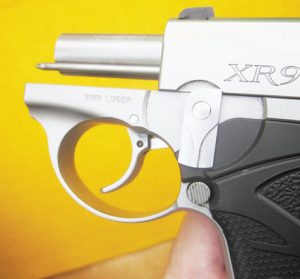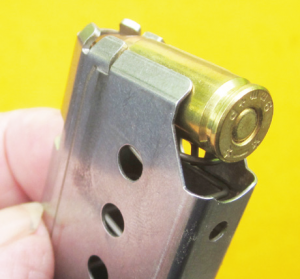by J.B. Wood Contributing Editor
In nearly all of the sub-compact pistols in 9 X 19mm chambering, there is one small problem: very short barrels. For most of them, the measurement of the rifled portion is barely two inches. Why is this important? Well, it means that the bullet of a 9mm Luger round does not have time to get up to its optimum velocity.
I said “nearly all” above, because there is now a pistol in this category that doesn’t have this problem: The Boberg XR9-S. It has a 3.35-inch barrel, with the rifled part measuring about 2.70 inches. With some of the more energetic 9mm loads, it can produce a muzzle velocity of up to 1,400 feet-per-second (fps), and 500 footpounds of energy.
And, this was done while keeping the whole thing at sub-compact size. The numbers: Overall length is 5.1 inches, and height 4.2 inches. The width is a slim 0.96 of an inch. Unloaded, the XR9-S weighs just 17.4 ounces. The frame is 7075-T6 aluminum, the grips Zytel polymer, and the rest high-grade stainless steel.
Now, how was this size-and-barrellength thing done? Design genius Arne Boberg extended the barrel way back, over the magazine well. Then, he devised a backward-feeding magazine system that may seem strange, but works perfectly. Twin “tongs” on a slidemounted lever pull the cartridge out rearward, onto a frame platform that lifts it up to the feed position.
For you firearms scholars, I’ll note that this basic principle was tried only once before, a very long time ago. In England, in 1895, a huge pistol called the “Mars” was designed by Hugh W.
Gabbett-Fairfax. Its first cartridge was a powerful bottle-neck of .360 caliber, and it used a backward-feeding magazine. There were several serous design mistakes, and by 1905 the “Mars” was gone.
Arne Boberg didn’t make any mistakes. His feeding system works perfectly. It has simple strength, and, unlike the Gabbett-Fairfax design, is entirely internal. Another good design point of the XR9-S is the use of a rotating-barrel locking system. The straight-line movement is good feeding, and the rotation speed will adjust to any load.
The rearward-feeding magazine of the XR9-S has one other unusual feature—there’s no follower. At the top, the end of the magazine spring is angled downward, and the cartridge sits on the spring. For anyone who just wants that little platform at the top, Boberg has one for $3.95 plus postage.
However, I will note that in all of my test-firing, the bare spring caused no problems.
Because of the unique feed system, there is no hold-open after the last shot. The takedown latch on the left side can be set at half-way position to hold the slide open for a brush-out of the bore. The magazine-release button is shielded against accidental depression.
There is no “magazine safety”.
The safety systems are the DA-Only trigger and an inertia-type firing pin.
The trigger pull is superb, and the smooth-faced trigger has no ridges. As the external hammer reaches fullcock, a very slight hesitation-point, so you can use the good squarepicture three-dot sights. Both of them are laterally adjustable, secured in their dovetails by Allen screws. At the upper rear of the frame there is a deep incurve that sits the XR9-S nicely in the hand.
When I took the pistol out to the Big Tree range, I tried it with two good 9mm loads. The one it liked best was a Plus-P 115-grain JHP from Black Hills. With a two-hand hold at 7 yards, the XR9-S consistently made 3.5-inch groups, wellcentered in the 8-inch black of the Champion VisiShot targets. As I have noted before, this corresponds to center-of-mass on combat silhouettes.
Considering its performance, highquality materials, and flawless workmanship, the suggested retail price of the Boberg is reasonable at $995. Other finishes are offered, and also the XR9-L, with a 4.2-inch barrel. The contact information: Boberg Arms Corporation, 1755 Commerce Court, Dept. TGM, White Bear Lake, MN 55110; phone: 651- 209-4812; online: BobergArms.com.






